
12 Best AI Tools for Content Creation in 2026


Rolling out a full campaign in a single morning felt impossible a few years ago.
Today, the right AI content creation tools turn briefs or files into on-brand drafts, visuals, short videos, and voiceovers that can be repurposed across channels with fewer handoffs.
And this isn’t just some hype.: McKinsey estimates generative AI can raise marketing productivity by 5% - 15% of total spend.
In other words, teams can create more campaigns in less time, with the same budget, freeing up time for strategy and creative work.
That’s the real promise of AI: faster turnarounds, more consistency and a team that spends more time thinking and less time chasing drafts.
In this guide, I’ll be sharing my hands-on experience from testing the 12 best AI tools for content creation in 2026. I’ll provide an overview of their features, pricing, and real-world examples for each tool.
After testing 12 AI tools, I came up with a quick 5-step evaluation process focused on first-hand experience that you can use when looking for the right software addition to the content team.
| AI Tool | Features | Pricing | G2 Ranking |
| Visme AI | Prompt-to-presentations/docs/social in editor, Brand Kit, AI touch-up, resize and translate, share link. | Free; paid plans from $12.25/month; custom pricing. | 4.5/5 (450+ reviews) |
| ChatGPT | Multimodal chat, custom GPTs, structured outputs, Drive/SharePoint/Slack connectors. | Free; paid plans from $20/month. | 4.7/5 (900+ reviews) |
| Jasper AI | Jasper IQ knowledge, Canvas, Agents. | Custom pricing; paid plans from $69/month. | 4.7/5 (1,250+ reviews) |
| Canva AI | Magic Design in editor, Brand Kit, Magic Switch resize and translator. | Free; and paid plans from $6.50/month; custom pricing. | 4.7/5 (5,800+ reviews) |
| Pictory | Text-to-video, auto subtitles, brand presets, stock library. | Paid plans from $25/month; custom pricing. | 4.7/5 (75+ reviews) |
| Murf.AI | Natural text-to-speech, multi-language voices, voice cloning, pronunciation control. | Free trial; paid plans from $29/month; custom pricing. | 4.7/5 (1,350+ reviews) |
| Gamma.app | Prompt and URL-to-deck, themes, PPT export. | Free; paid plans from $10/month. | 4.2/5 (10+ reviews) |
| GrammarlyGo | Inline writing support, brand tones, styling guides, app integration. | Free; paid plans from $12/month; custom pricing. | 4.7/5 (11,900+ reviews) |
| Descript | Edit-by-transcript, filler removal, Studio Sound, screen recorder, captions. | Free; paid plans from $16/month;custom pricing. | 4.6/5 (750+ reviews) |
| Gemini | Multimodal chat, long context, code/image/video generation. | Free; paid plans from $19.99/month. | 4.4/5 (260+ reviews) |
| Claude | Large context, Artifacts, memory retention, strong reasoning, PPT output. | Free; paid plans from $20/month; custom pricing. | 4.4/5 (60+ reviews) |
| Lovable | Prompt-to-full-app chat, GitHub sync, agent edits, deploy previews. | Free; paid plans from $25/month; custom pricing. | 4.5/5 (40+ reviews) |
Below are 12 tools you can deploy for your content creation strategy.
I prepared this list based on my experience working in the industry and included screenshots of tested perspective of how it typically performs in business workflows in 2026.
G2 Rating: 4.5/5 (450+ reviews)
Visme has become my go-to hub for visual content creation — and for good reason.
For a marketer who’s had to create different types of visuals, having everything in one place makes my work easier. I use it to design presentations, training content, marketing assets, social posts, videos and even animated and interactive projects.
The platform gives me access to thousands of professionally designed templates, plus a full set of design features, assets and interactive elements.
The AI Hub is where things really get exciting. It’s packed with tools that cover every step of the content creation process. You’ll find the AI Designer for full designs, an image generator for custom graphics, a text generator for copy, AI resize to instantly adapt designs to any format, and one-click photo editing tools to polish visuals.
It’s pretty rare to find a platform that combines all of this under one roof. To test the AI design generator, I used this prompt:
“Create a 6-slide ‘Interactive Virtual Booth’ deck for a B2B industrial brand.
Tone: clear, no hype. Style: clean and modern, use my Brand Wizard kit.
Slides: Hero with CTA, Map with four hotspots, Zone detail slides, and an On-Demand Webinar page.”
Next, I selected my preferred design theme. The idea was to create a presentation with an embedded on-demand webinar.
In seconds, the AI generated a clean gray-and blue-themed webinar presentation deck I could wire up using hotspots and other interactive elements. The AI understood the assignment. The copy, images and design elements aligned with the topic,
Plus, everything here is editable. Even if I didn’t like the first draft, I could have just asked the AI to regenerate or manually swap in the content or design elements.

Reviews happen in one live link with comments and analytics show who viewed what so you can track turnaround time, revision rate and reuse.
But Visme does much more than just presentations with AI. You can also use these features within the editor:

G2 Rating: 4.7/5 (900+ reviews)
ChatGPT is my favorite tool for fast ideas and drafts. I use the Plus version, which gives me GPT-4 and Deep Research which is perfect for digging into topics and pulling sources together.
When I need quick outlines, punchy copy, or a clean rewrite, I open ChatGPT. For this test, I asked it to find GPT’s best feature for 2026, break the answer into three sections, and end with a slide recap.
Eight minutes later, it delivered a brief called “GPT’s Best Overall Feature: An All-Round Conversational Powerhouse.” It covered three things: human-like conversation, style-controlled drafting, and coding support.
I skimmed the sources, swapped two weak links, and asked it to cut the text into a 120-word summary with a bullet slide. Start to finish, the whole process took about 12 minutes.

Beyond researching and idea generation, ChatGPT offers features that complement structured content ideation and creation such as:
G2 Rating: 4.7/5 (1.250+ reviews)
Jasper is a marketing-focused AI that turns briefs into on-brand blogs, emails and social. Everything inside a workspace that enforces voice, style and company knowledge.
I wanted to see if it could do the same for me.
So, I created an account, requested the free trial and onboarded with the quick survey.
I dropped Visme’s URL and let Jasper IQ draft a Brand Voice. Then, added “do/don’t use” terms, a reading-level target and a one-pager to the Knowledge Base.
Then I switched to Canvas, opened Jasper Chat, and prompted:
“Write a blog post about the benefits of using AI for marketing.” It created a doc titled “Boost Your Strategy: Top Benefits of AI for Marketing” and auto-structured it with H2s like “Improve Efficiency and Automate Repetitive Tasks.”
It even offered to draft the companion email. I clicked Continue and it generated “AI Marketing Blog Announcement Email” with the subject “Supercharging Your Marketing with AI” and a short preheader.
In 15 minutes, I had a blog and an email that I could use after making a couple of tweaks and curating content. The experience was smooth, though I didn’t love that Jasper required a credit card to start the free trial.

But that’s not the only thing Jasper does. Here’s a list of other features:
G2 Rating: 4.7/5 (5800+ reviews)
It’s hard to talk about modern visual content creation or design without mentioning Canva. Like Visme, it has a couple of AI tools that speed up design.
Give Canva a short brief or a reference image and the editor will generate layouts, images, presentations and more visuals on the canvas. Just tweak them and download them.
It works great for fast, on-brand mockups, presentations, videos, social posts and images that you can also resize or translate for every channel.
But I wanted to know how good it really was.
I jumped on Canva's website and clicked on the Canva AI option. It opened up an input field where I typed “Instant Draft Mode launch for B2B success. LinkedIn post 1080×1080, one headline, three value bullets, one CTA. Neutral B2B tone.”
I clicked on “Design for me” and waited a few seconds.
From a single prompt, it produced multiple hero concepts. I selected the laptop variant and published a 1080×1080 tile with a headline, three benefit bullets and a “Read the full post” CTA. I adjusted only a minor spacing issue. Everything else was ready to go.

Canva AI features include:
G2 Rating: 4.7/5 (75+ reviews)
Video is no longer optional for content teams and Pictory makes it fast
Pictory is an AI video creation tool that turns scripts, blog posts, URLs, images or recordings into videos ready to be used. It’s perfect for repurposing long-form content into short and branded clips fast.
I decided to put it to the test.
I entered the website and picked Text to Video as a feature to try. I chose the content dimension square 1:1 and pasted a 7-line script about “Instant Draft Mode.”
Pictory built a 7-scene timeline and I set the duration to 3.1s each for a 26.8s total.
Under Audio and Voiceover, I applied the AI voice Abby in English and Multilingual and kept music around 15 or 20%. Captions were on by default.
I switched to a clean subtitle style and edited two lines to keep on-screen text with less than 10 words. It gave me the option to switch 2 stock clips to actual videos, but chose not to.
Finally, I exported the video in MP4 1080×1080 with burned-in captions and ready for LinkedIn in about 15 minutes.

Here are other features in Pictory:
G2 Rating: 4.7/5 (1.350+ reviews)
Murf is one of the best AI voiceover generators available on the market. It turns a plain script into a polished AI voice narration.
I tried the Text to Speech functionality and pasted a 45s script with a headline, one benefit line, a “how it works” sentence and a clear CTA.
Then, I added pauses after each sentence and emphasized “faster launches,” “consistent tone,” and “fewer review loops.”
I also tried different voices like Natalie, Terrel and Zion to see which one hit the best tone and personality.
In the end, it produced a fine quick test for a promo that could be uploaded to social media as advertising.

Besides the text to speech functionality, there are other features Murf offers:
G2 Rating: 4.2/5 (10+ reviews)
Gamma is an AI design tool that turns a short brief or URL into a clean, card-based presentation or one-page site you can edit, theme, and share right from your browser.
I created a free trial account and used the AI Generator with this prompt:
“Conversion Experiment Plan: Freemium - Paid (Context, Goal, Hypothesis, Experiments, Timeline, Risks/Mitigations, Decision Ask. Clear B2B, no hype).”
Gamma returned with this output:

I regenerated the Risks section for sharper bullets and then clicked Publish to share a live link and exported PPT.
I ended up with a great website design mockup in 15 minutes. It worked great, although it got stuck a couple of times when thinking.
Here are other features you can find:
G2 Rating: 4.7/5 (11,900+ Reviews)
GrammarlyGO is one of the best AI copywriting tools in my opinion. Whenever I need to turn a rough or unclear copy into clear and executive-ready pieces fast, I use it.
It sits where I already write, including browser, Docs, Word or email and handles first drafts, rewrites, summaries and tone shifts without leaving my workflow.
I opened a Google Doc and pasted a 90-word paragraph on effective communication.
The tool marked the “Make concise and business-focused” card you see in the screenshot below, showing that I had some work to do.
I clicked Accept, then added in the prompt box: “Rewrite into two sentences, active voice, neutral B2B tone, outcomes first.”
GrammarlyGO returned a crisp two-sentence version with higher consistency and coordination and removed filler. Word count fell to 40 - 45 words, readability jumped, and the copy matched the B2B tone I was looking for.

I used three features here: Instant rewrite, clarity and concision suggestions and Prompt box in place.
Yet, there are a few more things GrammarlyGO can do:
G2 Rating: 4.6/5 (750+ reviews)
Looking to edit videos like a doc? Then Descript is an AI you should definitely try.
This is a transcript-first editing tool with AI cleanup that allows to include captions and social formats in one place.
It’s great for podcasts, webinars and quick explainers that you may need to do when going to a meeting with stakeholders.
I used the AI Video Generator for this test. I imported a 1:12 talking clip and let Descript auto-transcribe.
I turned on captions and then scrubbed to 00:26 and highlighted the clause around “precision, teamwork, and technology.” Hit Delete to drop a redundant phrase, and because it’s transcript-first, the video cuts with the text and the caption is updated instantly.
Just for fun, I ran the Remove Filler Words to tighten pacing and applied Studio Sound to clean room noise.
I ended up exporting the test video in 1920×1080 MP4 format with burned-in captions. In about 10 minutes, I had a 60-sec cut from a 1:12 video and removed everything I didn’t like from it.

Descript also has other interesting features that you could try, such as:
G2 Rating: 4.4/5 (260+ reviews)
Google’s multimodal assistant digests text, PDFs, images, screenshots, audio, short videos and turns them into cited briefs, slide outlines and creative variants you can export.
Because it’s tied into Google’s ecosystem, it’s possible to pull context from Gmail/Docs/Drive and share as links, slides, or pages. It even connects with Google’s video/image tools like Veo to get image assets.
I got into Gemini free and asked to turn a single article about Google E-E-A-T into a small campaign kit. I opened a new chat, pasted the URL and ran the prompt below:
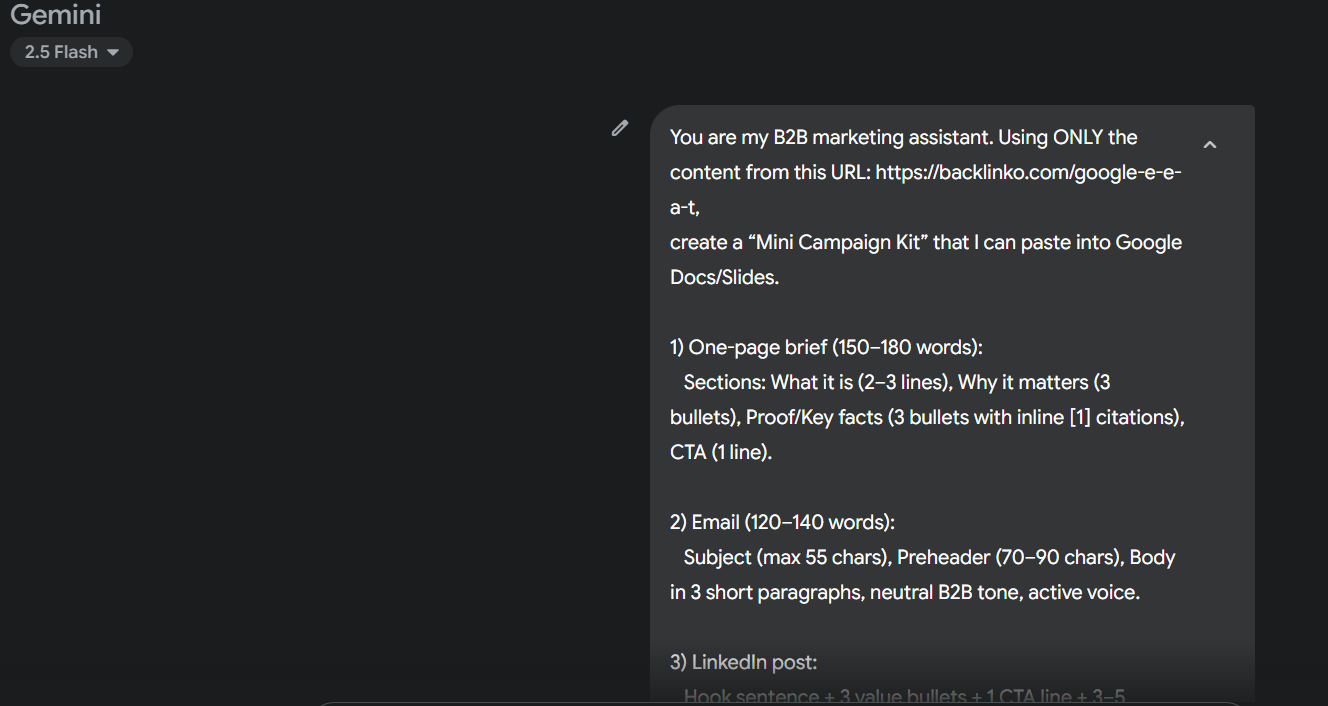
Gemini returned a one-page brief that included what it is, why it matters, Proof with bracketed citations, and CTA. It also included a 140-word email, a LinkedIn post with a hook, three bullets, a CTA, and hashtags, a 5-slide carousel outline, a 30-second video script and a CSV of five key facts with quotes.
I skimmed claims and pasted the outputs into Docs/Slides. Everything was done in about 3 minutes.

Although the result was great, what is most interesting are the additional features it has:
Claude is Anthropic’s reasoning-first assistant tool for analysis and coding.
It turns long inputs like docs, PDFs or screenshots into decision-ready briefings and working prototypes in a single thread and explains the whole process in the meantime.
For content and growth teams, that means fewer back-and-forths and easier concept-to-market scenarios. It’s a clean way to move from “what should we build?” to a clickable demo you can show in your next meeting.
So, for my test, I opened Claude 4.1 and used the three queries available in the free plan to see if that was enough to make a functional prototype.
I pasted this prompt to generate a brand kit for a new feature called Quick Draft:
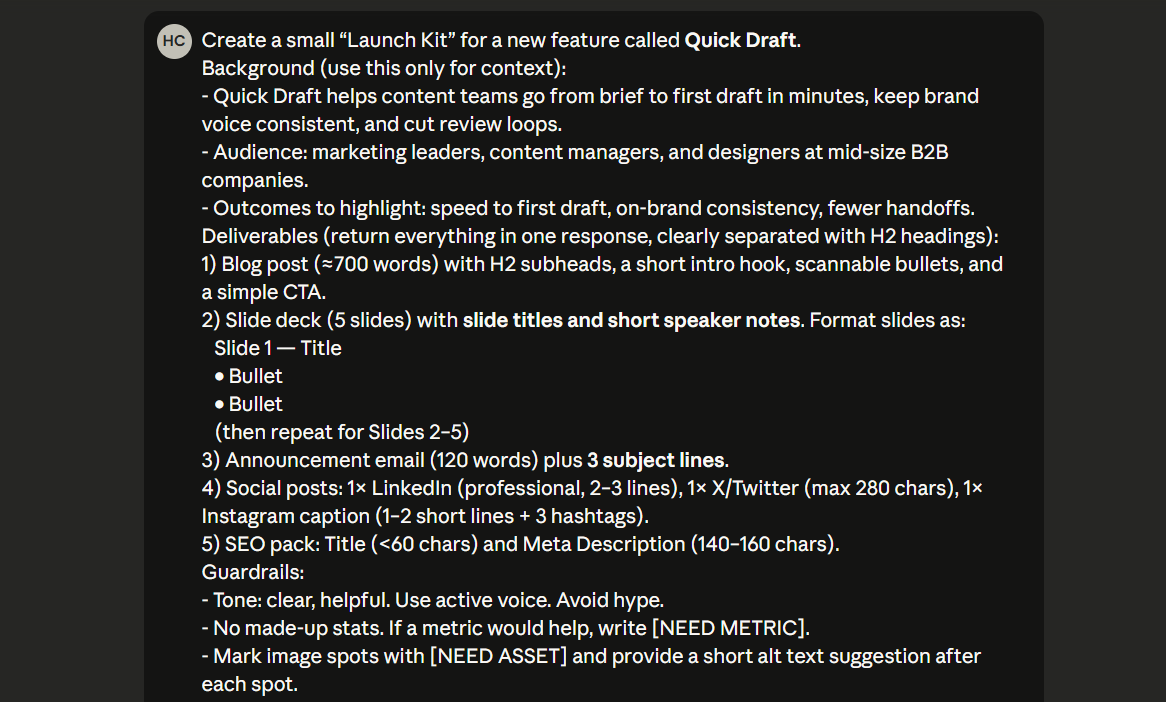
Claude returned the complete brand kit with copy, meta title and description, social posts, presentation slide suggestions and the blog post output in less than 10 minutes.
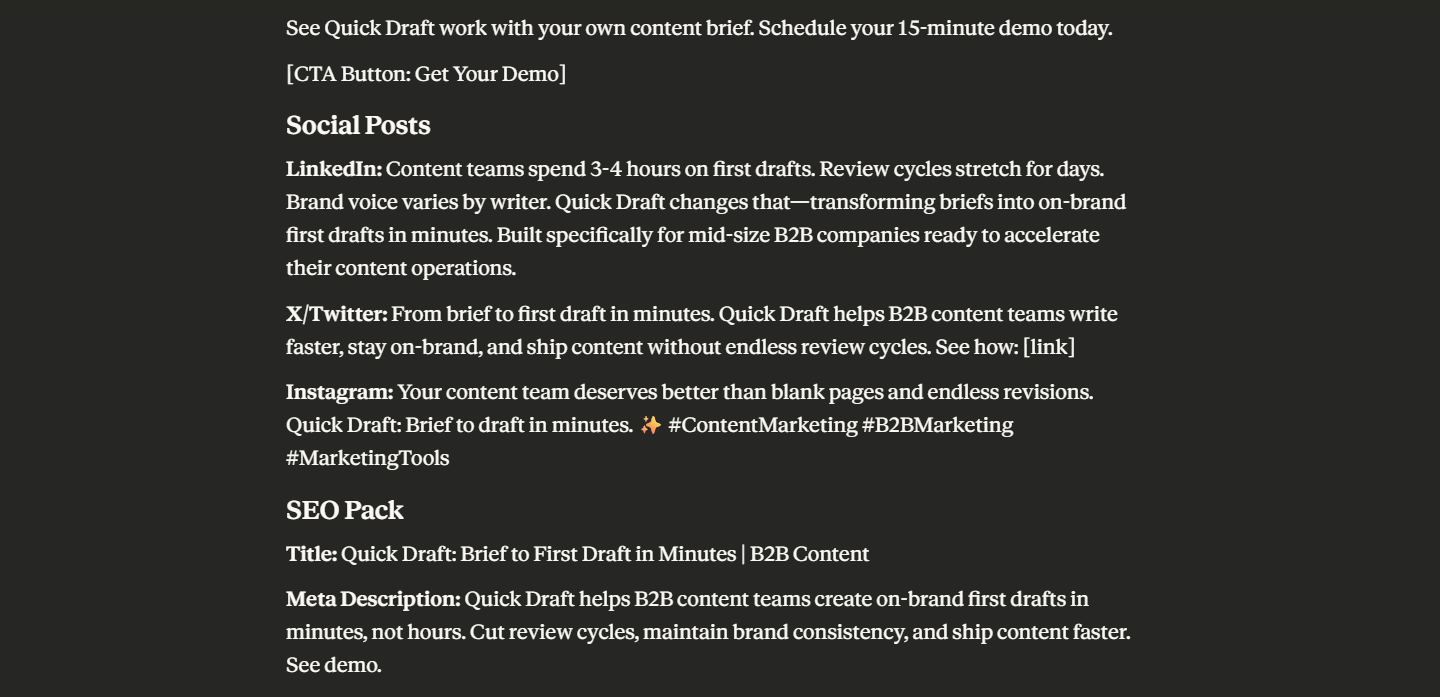
It really impressed me how good Opus 4.1 and its prompting feature works. Some other functionalities you shouldn’t miss include:
G2 Rating: 4.5/5 (40+ reviews)
Lovable is an AI prototyping platform that turns plain language prompts into working web apps with UI, logic, backend, and deployment and keeps real code synced to your GitHub so you own it.
What I like is the dual workflow. You can plan in Chat Mode, then flip to Agent Mode to implement changes in the same canvas. It’s great for non-coders and to make visual tweaks.
For founders and content teams, it’s a quick way to validate ideas, demo flows to stakeholders, and hand developers editable code instead of mockups.
In my test, I made a quick web page mockup test with Lovable free tier since it gives five queries per day.
I used the prompt: “Build a web page mockup that showcases AI rankings, including sections for top tools, features, and user ratings.”
The AI showed how it worked in the left panel and replied with a design vision with a modern tech look, blue/purple gradients, clean cards with star ratings, and generated a hero titled “Discover the Best AI Tools of 2024.”
It added the subhead referencing comparisons and user reviews, trust badges and two CTAs “Explore Top AI Tools” and “View Rankings.”
I used Visual Edits to tighten the headline and button labels, then bumped H1 size and spacing in Code Mode for a cleaner fold.
I clicked Publish to get a shareable preview and ensured the GitHub sync captured every change.
Total time? It took me 10 minutes to prepare a polished and working MVP that I could use as a landing page.
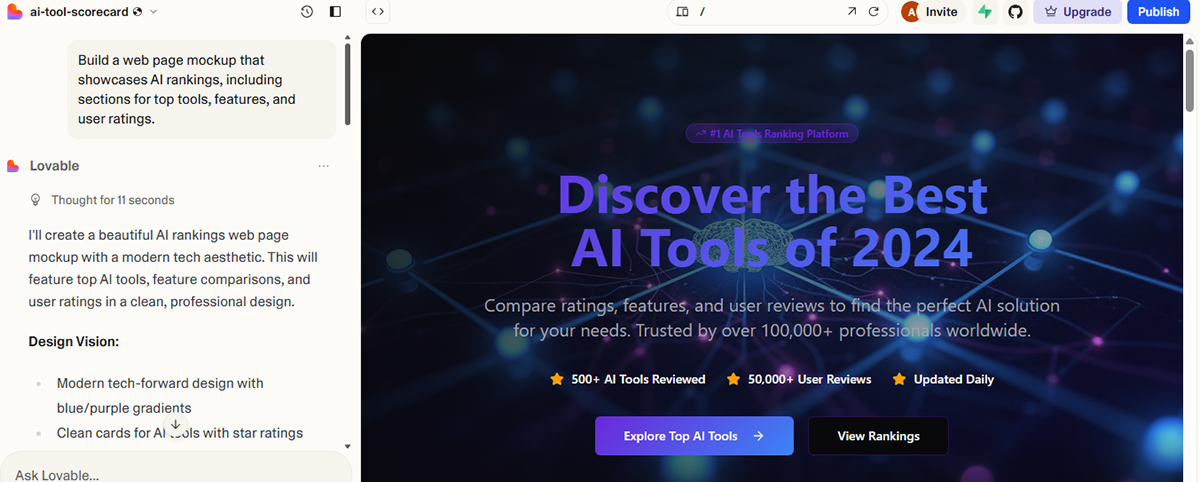
This test was amazing. But if that surprised you, here are all the features you can expect when using Lovable:
Bonus: SEO & Content Creation AI Tool
There are a lot of new AI tools out there, and some just don’t live up to the hype. But I found one that’s worth an honorable mention and a test drive, Seobot AI.
The name may be on the nose, but Seobot AI is more than that. It’s an automated SEO tool that uses AI agents to handle content creation and optimization for blogs and websites.
It’s built for founders and marketers juggling multiple projects, automating everything from keyword research to publishing SEO-optimized articles.
After testing it out, I found it especially useful for teams producing high volumes of content while keeping their focus on strategy and growth.
The tool has already generated over 100,000 articles, driving 0.6 billion impressions and 15 million clicks — proving it can help support traffic-building efforts. Still, you’ll want to add a human touch to the copy and train the AI to match your brand voice before fully relying on it.
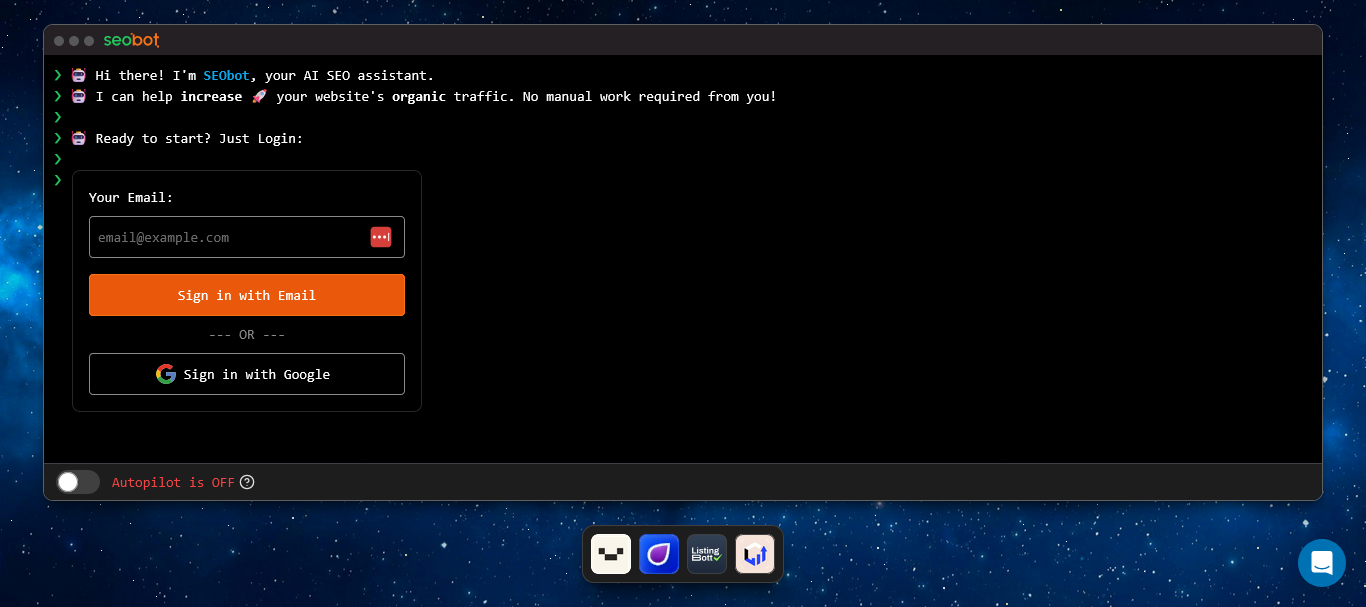
These eight points will help you make a smart decision when considering the right AI tool for your content team.
AI is settling into the role of amplifier for content teams and the entire creative thinking process.
As Chris Simental, Co-Founder at RIPE, notes,
"We're watching hybrid AI-human collaboration become the real differentiator. Tools that treat AI as a co-pilot, rather than an autopilot, are the ones that seem to stick."
The practical shift is to stop chasing new apps and build an AI content supply chain with defined inputs, brand rules, review gates and measurement.
Over the next 2 to 5 years, expect embedded copilots across your stack, whether that is inside Docs, email, CMS and design tools that will support research, drafting, design and QA.
Teams that win will standardize prompts and templates, enforce brand voice via styling guides and keep human review at clear checkpoints to ensure consistency.
Leaders like Sundar Pichai and Ginni Rometty emphasize that advantage comes from operationalizing AI inside the workflow to speed things up and scale faster.
The risk is volume without judgment, which demands stronger editorial standards.
The real move is in preparing multimodal workflows with human touch points so teams move from brief to draft, review and publish with fewer handoffs to maintain stakeholders’ on check.
Mark Cuban, agrees with this when he says that “AI can significantly aid the creative process.” However, he offers a critical perspective when mentioning that “it cannot entirely automate it… human judgment is essential in making final decisions.”
This reinforces the idea that AI without supervision won’t make it in the long run. But teams that combine human effort with AI automations will produce better results in less time.
The best AI tool for content creation depends on your goal. Use ChatGPT for ideation, Jasper for brand-aligned writing and Visme AI for visual content creation.
Pictory is the best AI tool for video content creation, while Murf.ai is for voice. Pick on outcomes: speed to first draft, on-brand score, edit time and cost per shipped asset.
Yes, AI can do content creation. But thought leadership, brand nuance and strategic context still require humans. Use tools to accelerate, not to automate blindly.
The best AI content generators include Visme, Lovable and Canva AI.
The four types of AI tools are:
To use prompts for better AI content, be specific about goal, audience, structure, tone, constraints and source. Give an example, formatting rules, and state what to avoid.
Yes, AI content creation is worth it if you measure it. Track time-to-first-draft, percentage of edits to publish, cost per asset and performance lift (CTR/engagement).
Consider that if AI cuts creation time by 40% without hurting quality, it’s paying for itself.
No, ChatGPT is not the best AI. While it is strong in general drafting and reasoning, the term “best” depends on the specific use case. For marketing brand control, Jasper often works better. For multimodal research, Gemini is more suitable.
For analysis and coding, Claude excels, while for visuals, Visme AI is the preferred choice. When selecting an AI, consider how well it fits your workflow, governance needs, and overall costs instead of relying on hype.
Yes, there is a free AI tool to write content. ChatGPT, Gemini and Claude all produce drafts with usage limits. Free tiers are great for trials.
AI isn't a shiny new toy. High-performing teams rely on AI tools to work faster, stay on brand and ship out more content without burning out.
The right tools cut through the busywork and help you go from a blank page to polished content in record time.
Visme AI gives you everything you need in one place. The AI Presentation Maker builds slides that look professional right out of the gate. The AI Writer helps you generate, edit, and polish copy that fits your message. The AI Designer and Image Editor let you create charts, graphics and visuals that make your ideas stand out. You can even add natural-sounding voiceovers with text-to-speech, and Brand Wizard keeps every asset on-brand with the right fonts, colors, and logos.
Everything is in one platform, so you can ideate, design, write, and publish without bouncing between tools or sacrificing quality.
Ready to streamline your workflow and ship better content faster? Try Visme’s AI Design Generator today and see how effortless content creation can be.
Supercharge your content creation and designs in minutes with the power of the AI Designer.
Try for Free